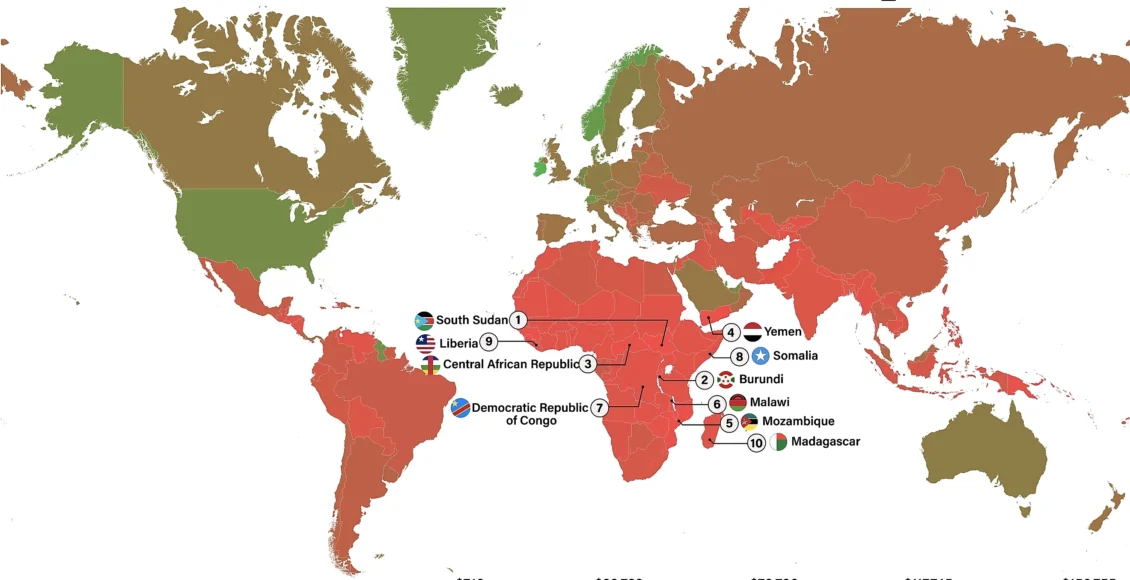The World Bank’s 2025 report, The Great Reversal, offers a sobering reflection on where global development stands today and more importantly, where it is headed. For 75 of the world’s poorest countries, known collectively as IDA countries, the story is one of mounting vulnerability. These nations considered to be home to nearly 1.9 billion people, are facing a silent crisis that could soon become a global emergency.
These countries, mainly located in Sub-Saharan Africa and parts of Asia, account for nearly a quarter of the world’s population, but their combined share of global economic output is just 3 per cent. Even more alarming is the fact that over 70 per cent of the world’s extreme poor live in these regions. The report warns that decades of development progress are at risk of being reversed and the warning comes not a moment too soon.
The Covid-19 pandemic dealt a heavy blow. In 2020, GDP growth in IDA countries plunged to 0.3 per cent, the lowest since the early 1980s. While many other economies showed signs of rebound by 2021, these countries struggled to regain their footing. For fragile states and small island economies, the economic fallout was especially devastating. Though some growth returned in 2021, the momentum fizzled out, and by 2024, overall output in these countries is expected to remain well below pre-pandemic trends. Shockingly, one in three IDA countries will have lower per capita income in 2024 than they did five years ago.
These aren’t just numbers. Behind each percentage point is a child pulled out of school, a family sliding into hunger, a young person unable to find work. The human cost of what the Bank calls “The Great Reversal” is immense.
Consider this: half of all IDA countries are now growing more slowly than advanced economies. The poverty gap is widening again after decades of narrowing. In 2023, 26.5 per cent of people in IDA countries lived below the international poverty line of $2.15 a day which is more than eight times the global average. Food insecurity, too, is rampant: over 650 million people across these nations cannot meet their daily nutrition needs.
But this crisis is not merely the result of the pandemic. It has deeper roots such as weak institutions, low public revenues, limited capacity to invest in health and education, and underdeveloped financial systems. On average, government revenue in these countries stands at just 11.9 per cent of GDP, compared to 17.1 per cent in other developing economies. Health spending averages only 1.6 per cent of GDP; education fares slightly better at 3.6 per cent. This chronic underinvestment in human development weakens resilience and hampers recovery.
Climate change has added yet another layer of distress. IDA countries lose around 1.3 per cent of their GDP annually to natural disasters are more than double the losses seen in other low- and middle-income countries. In the Sahel region, desertification is spreading at a worrying pace, and floods, droughts, and cyclones are becoming more frequent and more damaging. The majority of these nations rely heavily on agriculture, often of the subsistence variety. When climate shocks hit, entire communities lose both income and food.
Many of these countries are also grappling with mounting debt burdens. With limited fiscal space and little room to maneuver, their governments are being forced to make impossible choices between paying off external debt and investing in public welfare. Without urgent support, the risk is clear: these countries could become locked in a vicious cycle of stagnation, social unrest, and deepening poverty.
Yet despite the bleak headlines, the picture is not without hope. History offers compelling examples. Countries like China, India, and South Korea were once IDA recipients. They transitioned, through hard choices, sound policy, and international support, into global growth engines. Many of today’s IDA countries are also richly endowed with natural resources, including minerals critical to the green energy transition. More importantly, they have young populations. In a world where many advanced economies are ageing, these countries possess a demographic dividend that, if harnessed wisely, could become a powerful engine of growth.
But potential needs policy. National governments must act decisively to restore economic stability, strengthen institutions, and improve public services. Investing in education and healthcare is not a luxury, it is a necessity. Equally, digital infrastructure and climate adaptation must be prioritised to build more resilient economies.
At the same time, this cannot be a solo effort. The international community must step up. Scaled-up concessional financing, debt relief, and global cooperation on trade and investment are not just desirable, they are essential. Without these, even the best-intentioned reforms may falter.
This is a moment of reckoning for the global development community. We can either rise to the challenge and help these countries break out of the trap, or we can watch a whole generation lose its chance. A crisis of this scale does not remain contained. Poverty, displacement, food insecurity, and climate vulnerability are borderless problems. The success or failure of IDA countries will shape the world’s collective future.
The Great Reversal is more than just a report, it is a call to action. It reminds us that solidarity is not just a moral ideal; it is a practical necessity. If the world hopes to meet its commitments on poverty, climate, and peace, the IDA crisis must move from the margins to the centre of global concern.
Helping IDA countries recover is not charity, it is shared responsibility. In the end, the road to global stability and prosperity runs through the villages, schools, and clinics of the world’s poorest nations. Now is the time to walk that road together.
Stay updated with the latest news, analyses, and daily happenings —
join
The Catchline’s official WhatsApp channel today!



